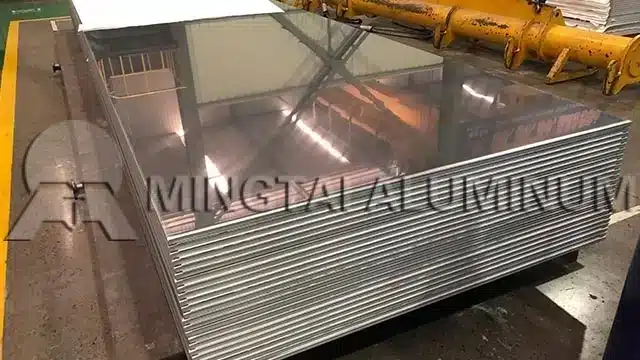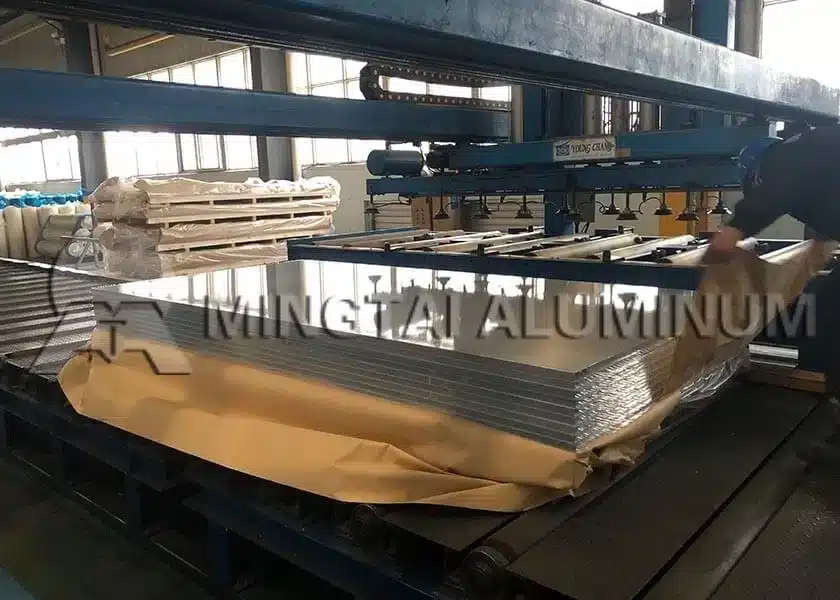
What Is 6101-T63 Aluminum Sheet?
The 6101-T63 aluminum sheet is a special blend from the 6xxx aluminum-magnesium-silicon family. It’s made to carry electricity really well while still being pretty tough. This makes it awesome for stuff like busbars, electric vehicle (EV) battery connectors, and power systems.
The T63 temper comes from a heat process. It gets heated up, then aged on purpose. This makes it stronger without messing up its ability to conduct electricity. It’s great for parts that move heat or power.
MINGTAI ALUMINUM says the 6101-T63 sheet comes in these sizes:
- Thickness: 0.5 mm – 500 mm
- Width: 20 mm – 2650 mm
- Length: 500 mm – 16000 mm
- Tempers: T4, T6, T63, T451, F, O, H112
Those big numbers show what they can make. But most busbar and electrical jobs use sheets 2 mm to 50 mm thick and 100 mm to 1000 mm wide.
6101-T63 Aluminum Sheet in Electrical Applications
In today’s electrical world, 6101-T63 is a go-to instead of copper. It’s got about 55% IACS conductivity and is super light.
It handles big electric currents and stays solid. You’ll see it in:
- Busbars and switchgear setups
- EV battery connectors and charging bits
- Heat sinks and power gadget cases
- Green energy power systems
It welds nicely, fights rust, and takes coatings well. This keeps it working for a long time, even outside or under heavy use.
Why Compare 6101-T63, 6061, and 6063
The 6101-T63 is built for carrying electricity. But 6061 and 6063 are used for other things.
- 6061 aluminum sheets are tougher and stronger. They’re great for car parts, molds, or heavy-duty builds.
- 6063 sheets shape easily and look smooth. They’re perfect for building frames or LED cases.
Knowing what sets them apart helps you pick the right one. You weigh conductivity, strength, and how easy it is to make for your job.
6101-T63 Aluminum Sheet Composition and Properties
Chemical and Mechanical Comparison
| Alloy | Si (%) | Mg (%) | Cu (%) | Typical Strength (MPa) | Conductivity (% IACS) |
| 6101-T63 | 0.3–0.7 | 0.35–0.8 | ≤ 0.05 | 190–220 | ≈ 55 |
| 6061-T6 | 0.4–0.8 | 0.8–1.2 | 0.15–0.4 | 260–310 | 40–45 |
| 6063-T5 | 0.2–0.6 | 0.45–0.9 | ≤ 0.10 | 150–190 | 52–55 |
Data based on ASTM B317 / EN AW 6101 / GB T 3190 typical values.
The 6101-T63 gets strong through a hardening trick. It still conducts electricity better than most 6xxx alloys. It has low copper, so it resists rust and doesn’t block current. That’s a big win for electrical work.
Conductivity and Strength Balance
With about 55% IACS conductivity, 6101-T63 moves current well in busbar setups. It’s also tough enough to hold up.
Compare that to:
- 6061-T6, which is stronger but only hits ~40% IACS.
- 6063-T5, which shapes better and takes coatings nicely but isn’t as tough.
So, 6101-T63 is the best pick for electrical parts needing both conductivity and strength.
6101-T63 Aluminum Sheet Temper and Processing
What Makes the T63 Temper Different
The T63 temper uses a special heat process. It starts with heating, then aging on purpose. This mixes strength, bendiness, and conductivity just right.
Compared to T6, which is all about strength, or T5, which is for fast shaping, T63 nails it for electrical sheets and busbar stock.
Workability and Surface Treatment
The 6101-T63 sheet gives you:
- Awesome welding (works with MIG, TIG, or friction welding)
- Good rust protection in wet or factory settings
- Easy fit with anodizing, chemical coatings, or protective layers
These make it last long in switchgear, EV setups, or green energy systems. Conductivity and toughness against the environment are key.
6101-T63 Aluminum Sheet Applications and Selection
Electrical and Industrial Uses
You’ll find it in:
- Busbars and power panels
- Switchgear connectors and transformer wires
- EV battery parts and charging setups
- Heat control and current-moving parts
Its light weight and great conductivity make it a cheap, energy-saving choice.
Choosing Between 6101-T63, 6061, and 6063
| Application Priority | Recommended Alloy | Key Advantage |
| Highest conductivity | 6101-T63 | Electrical-grade performance (~55 % IACS) |
| Highest mechanical strength | 6061-T6 | Structural durability and machinability |
| Best surface quality / extrudability | 6063-T5 | Superior anodizing and forming performance |
Here’s the deal:
- Grab 6101-T63 for busbars, connectors, or EV power bits.
- Pick 6061 for heavy or machined parts.
- Go with 6063 for pretty building frames or profiles.

If you’re an engineer or designer looking for aluminum that conducts electricity well, stays strong, and fights rust, the 6101-T63 sheet is a great bet.
It sits between pure conductive metals and structural aluminum. It’s a star in busbars, switchgear, and EV power systems.
MINGTAI ALUMINUM rolls out 6101-T63 sheets that meet ASTM B209, ASTM B317, EN AW 6101, and GB/T 3190 standards.
You can get custom sizes:
- Thickness: 0.5 – 500 mm
- Width: 20 – 2650 mm
- Length: 500 – 16000 mm
- Tempers: T4 / T6 / T63 / T451 / F / O / H112
With top-notch rolling gear and strict checks, MINGTAI ALUMINUM keeps conductivity steady, sizes exact, and strength reliable. This helps you get solid, long-lasting results in tough electrical jobs.
FAQ
Q: What’s the big difference between 6101-T63 and 6061?
A: The 6101-T63 is all about carrying electricity (~55% IACS). The 6061 is about strength. Use 6101-T63 for busbars or conductors. Pick 6061 for structural or machined stuff.
Q: Can 6101-T63 replace copper in electrical setups?
A: Yup. It conducts well and weighs less. The 6101-T63 swaps in for copper in busbars, switchgear, or transformers. It saves cash and weight.
Q: What tempers can you get for 6101 aluminum sheet?
A: MINGTAI ALUMINUM has tempers like T4, T6, T63, T451, F, O, and H112. The T63 is best for balancing conductivity and strength in electrical jobs.
Q: How does 6101-T63 do with welding and rust?
A: It welds great and holds up against rust in wet or industrial spots. That makes it solid for outdoor power systems or green energy gear.




